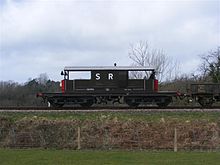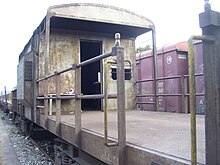
A bogie is a chassis or framework that carries a wheelset, attached to a vehicle—a modular subassembly of wheels and axles. Bogies take various forms in various modes of transport. A bogie may remain normally attached or be quickly detachable. It may include a suspension component within it, or be solid and in turn be suspended ; it may be mounted on a swivel, as traditionally on a railway carriage or locomotive, additionally jointed and sprung, or held in place by other means.
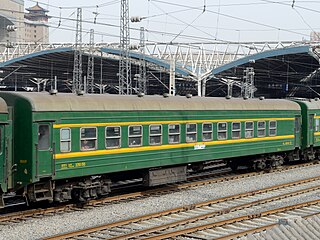
A railroad car, railcar, railway wagon, railway carriage, railway truck, railwagon, railcarriage or railtruck, also called a train car, train wagon, train carriage or train truck, is a vehicle used for the carrying of cargo or passengers on a rail transport network. Such cars, when coupled together and hauled by one or more locomotives, form a train. Alternatively, some passenger cars are self-propelled in which case they may be either single railcars or make up multiple units.
The Armagh rail disaster happened on 12 June 1889 near Armagh, County Armagh, in Ireland, when a crowded Sunday school excursion train had to negotiate a steep incline; the steam locomotive was unable to complete the climb and the train stalled. The train crew decided to divide the train and take forward the front portion, leaving the rear portion on the running line. The rear portion was inadequately braked and ran back down the gradient, colliding with a following train.

The vacuum brake is a braking system employed on trains and introduced in the mid-1860s. A variant, the automatic vacuum brake system, became almost universal in British train equipment and in countries influenced by British practice. Vacuum brakes also enjoyed a brief period of adoption in the United States, primarily on narrow-gauge railroads. Their limitations caused them to be progressively superseded by compressed air systems starting in the United Kingdom from the 1970s onward. The vacuum brake system is now obsolete; it is not in large-scale usage anywhere in the world, other than in South Africa, largely supplanted by air brakes.
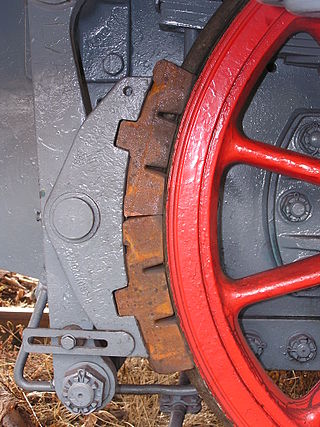
A railway brake is a type of brake used on the cars of railway trains to enable deceleration, control acceleration (downhill) or to keep them immobile when parked. While the basic principle is similar to that on road vehicle usage, operational features are more complex because of the need to control multiple linked carriages and to be effective on vehicles left without a prime mover. Clasp brakes are one type of brakes historically used on trains.
The Charfield railway disaster was a fatal train crash which occurred on 13 October 1928 in the village of Charfield in the English county of Gloucestershire. The London, Midland and Scottish Railway (LMS) Leeds to Bristol night mail train failed to stop at the signals protecting the down refuge siding at Charfield railway station. The weather was misty, but there was not a sufficiently thick fog for the signalman at Charfield to employ fog signalmen. A freight train was in the process of being shunted from the down main line to the siding, and another train of empty goods wagons was passing through the station from the Bristol (up) direction.
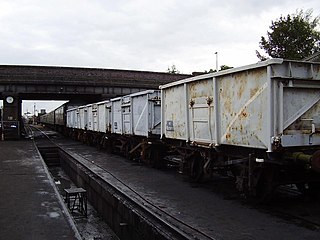
A mineral wagon or coal truck is a small open-topped railway goods wagon used in the United Kingdom and elsewhere to carry coal, ores and other mine products.
Brake force, also known as brake power, is a measure of force applied by the brakes of a vehicle in order to decelerate it. It is one of the main components in determining a vehicle's stopping distance.
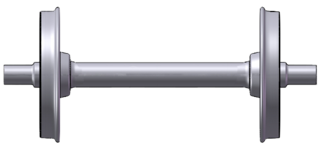
A wheelset is a pair of railroad vehicle wheels mounted rigidly on an axle such that both wheels rotate in unison. Wheelsets are often mounted in a bogie – a pivoted frame assembly holding at least two wheelsets – at each end of the vehicle. Most modern freight cars and passenger cars have bogies each with two wheelsets, but three wheelsets are used in bogies of freight cars that carry heavy loads, and three-wheelset bogies are under some passenger cars. Four-wheeled goods wagons that were once near-universal in Europe and Great Britain and their colonies have only two wheelsets; in recent decades such vehicles have become less common as trainloads have become heavier.
The rolling stock used on the Isle of Man Railway today is entirely original although, from an original total of 75 carriages, the number serviceable dropped as low as 14, but this total is once again increasing as a result of recent rebuilds The 3 ft gauge railway was provided with a variety of stock from different manufacturers over its time, and types of coach were categorised according to a lettering system, with the original four-wheeled coaches being of A, B, C and D types, and so on. The F prefix encompassed all bogie vehicles including conversions from the A-D series. Letters G-M denoted goods stock. N referred to ex-Manx Northern Railway 6 wheel carriages. The types of stock can be summarised as follows:-
The Victorian Railways used a variety of railway wagons for the transport of livestock.
This article contains information on Victorian Railways rolling stock that do not fit into other categories. These were for the most part "one-offs"; many were not classified.
As the Victorian Railways' fleet of Z vans began to age, the railways decided to invest in bogie designs for vans. Some van designs were included in a class of new passenger vehicles. Many other vans, for both freight and passenger work, were built separately from any other rolling stock developments, and these are the ones that feature here in detail.
This article lists some of the terminology used at present and in the past by railway employees, railway enthusiasts and railway historians in Australia. Many appear from time to time in specialist, rail-related publications. Significant regional variations exist, indicated by abbreviations of the state or railway.

The fleet of Great Western Railway wagons was both large and varied as it carried the wide variety of goods traffic on the Great Western Railway (GWR) in the United Kingdom. This was the railway company that operated for the longest period of time in the country and covered a large geographical area that included big cities such as London, industrialised areas including the West Midlands, areas of coal and mineral mining such as South Wales, and Somerset and other important agricultural districts. In 1902 the company owned 59,036 wagons, and by 1926 this had risen to 88,580.

The GWR Toad is a class of railway brake van, designed by and built for the Great Western Railway. Used by the GWR from 1894, and post-1947 by the Western Region of British Railways, its role was a safety brake on goods trains in the West of England, the Midlands and Wales.
Buffers and chain couplers are the de facto International Union of Railways (UIC) standard railway coupling used in the EU and UK, and on some surviving former colonial railways, such as in South America and India, on older rolling stock. Buffers and chain couplers are an assembly of several devices: buffers, hooks and links, or turnbuckle screws.
The Victorian Railways used a variety of air-cooled and iced wagons for the transport of all manner of goods. This page covers the history and development of the various classes, and how they changed through their lives.

British Railways inherited a variety of brake vans from each of the Big Four: GWR, LNER, Southern Railway and LMS due to the nationalisation of the railways in 1948.
The Victorian Railways used a variety of former traffic wagons around depots and for specific construction, maintenance and similar tasks. Very few of these vehicles were specially constructed from scratch, often instead recycling components or whole wagon bodies and frames from old vehicles that had been withdrawn from normal service as life-expired or superseded by a better design.

